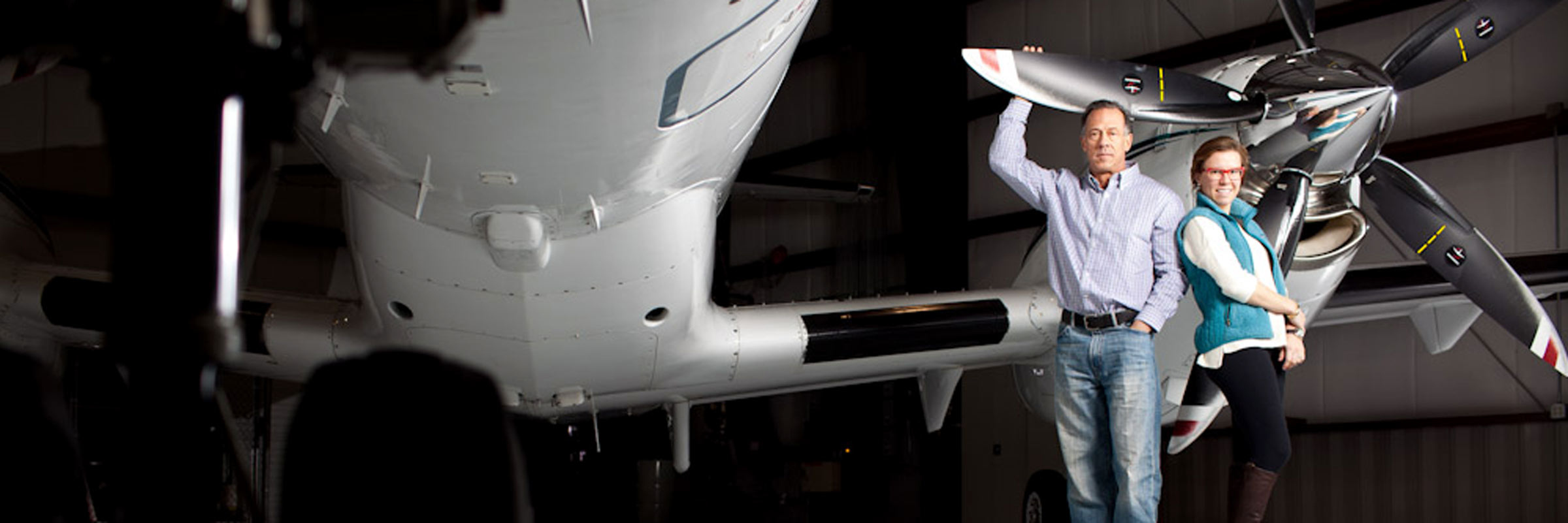July 8, 2010 started perfectly for Tonie Michaels ’14 and her father, James. She had just earned her pilot’s license and was joining her dad—a lifelong pilot—on a long-awaited series of aviation adventures stretching from their native Wisconsin to Colorado. They took off that morning from Greeley, Colo., heading to Vail for some shopping. James was flying; the weather was clear. By noon, they had reached Estes Park in northern Colorado, and the views of the green hills from a few thousand feet above were breathtaking.
Then, without warning, fifteen seconds of catastrophe: A freak downdraft started to pull the plane down at more than 120 miles per hour. James tried to pull the plane up and to the right to escape the draft. It didn’t work. They were going down.
It was at that moment that James’ mind flashed back to a good friend of his who had died in a crash 10 years earlier despite following the prevailing flight technique for such a situation: slow the plane down and land it in the treetops and—hopefully—settle to the ground. When his friend attempted this, the plane ended up hitting the ground vertically and with such force that it tore the plane’s seatbelts and—even though he was wearing a helmet—crushed his skull. Troubled by the death, James sought to find out what could have saved his friend, eventually learning from a decorated aviator and mountain crash survivor that the best approach would have been to try to navigate a slow path through the trees and put the plane on the ground—letting the branches strip the plane and further reduce its forward momentum.
So as the plane descended, James evened out and decreased his speed to about 65 miles per hour—the slowest flight speed possible without having the plane simply fall out of the sky. He yelled back to Tonie to brace herself, and she held on tight with both hands to the straps of her five-point harness. Tonie’s mind had gone blank. In the lengthy moment when the two were waiting to hit the oncoming trees on a mountain, James managed a final thought: “She’s dead. Everything was going right. And now my daughter is going to die.”
The right wing hit the first tree with a loud thud. The cockpit windows broke and air rushed in. More trees, more thuds, and they were suddenly at a stop, the plane sideways between trees. Fuel was everywhere. They unbuckled and rushed from the plane, fearing it would erupt in flames.
There was no emotional moment, though—no hugging, no crying. Celebration would have been premature. After a quick injury assessment—a scratch on James’ leg, an elbow knock that Tonie shrugged off (later revealed to be a fracture)—they began planning how to stay alive in the middle of the forest for their foreseeable future. Rain was forecast for the afternoon, and they knew temperatures would likely reach freezing overnight. They needed to stay dry and warm. So they set about constructing a makeshift tent from plane parts and nearby branches. James managed to collect a few ounces of fuel from the split-open tanks in an empty shampoo bottle, and they used one of Tonie’s Harry Potter books and a spark from the plane’s battery to start two fires—one fairly close to the plane and another in a small nearby clearing as an alert to any possible rescuers. With no cell phone service, it was the best they could hope for in terms of communication. To blacken the second fire’s smoke and make it more noticeable, they added a tire from the plane.
Tonie, a Denison field hockey player, was obviously uneasy. First of all, she hates camping. Those class camping trips in high school? The worst weekends of her life. And secondly—more urgently—she couldn’t stop thinking about what happens if no one found them. She had heard the stories of people in such a situation being found two weeks later, dead of dehydration or starvation. And all she and her dad had was a single water bottle and one pack of tuna.
By evening, Rocky Mountain National Park rangers had been alerted to the plane’s distress signals and sent out two planes to locate the source. They honed in on the signal and saw two points of light—the two fires—nearby. When James and Tonie heard a plane start circling overhead around 8 p.m., they celebrated by opening the tuna. Still, Tonie didn’t sleep much that night. James didn’t sleep at all.
At 6:40 the next morning, two rangers arrived at the crash site and were awestruck. The lead ranger looked up the hill at James and Tonie, and at the airplane sitting sideways in the trees, wings folded back. He sat down on a stump, dumbfounded. These things, he told the Michaels, don’t usually turn out so well.
Soon after the rescue, James called the veteran aviator who had given him the landing advice so many years back, as well as the family of his friend who had died in the mountain crash, to tell them that their son’s death had helped save his and his daughter’s lives. And now they are paying it forward, recounting their experience as part of a safety seminar at aviation conferences. The information had saved their lives—and might now save others.

